Australian megafauna
The term Australian megafauna refers to a number of large animal species in Australia, often defined as species with body mass estimates of greater than 45 kg (100 lb)[1] or equal to or greater than 130% of the body mass of their closest living relatives, that lived during the Pleistocene Epoch. Most of these species became extinct during the latter half of the Pleistocene, and the roles of human and climatic factors in their extinction are contested.
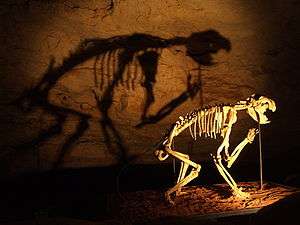
There are similarities between prehistoric Australian megafauna and some mythical creatures from the Aboriginal Dreamtime.[2]
Causes of extinction
Many modern researchers, including Tim Flannery, think that with the arrival of early Aboriginal Australians (around 70,000~65,000 years ago), hunting and the use of fire to manage their environment may have contributed to the extinction of the megafauna.[3] Increased aridity during peak glaciation (about 18,000 years ago) may have also contributed, but most of the megafauna were already extinct by this time. Others, including Steve Wroe, note that records in the Australian Pleistocene are rare, and there is not enough data to definitively determine the time of extinction of many of the species, with many of the species having no confirmed record within the last 100,000 years. They suggest that many of the extinctions had been staggered over the course of the late Middle Pleistocene and early Late Pleistocene, prior to human arrival, due to climatic stress.[4]
New evidence based on accurate optically stimulated luminescence and uranium-thorium dating of megafaunal remains suggests that humans were the ultimate cause of the extinction for some of the megafauna in Australia.[5][6] The dates derived show that all forms of megafauna on the Australian mainland became extinct in the same rapid timeframe—approximately 46,000 years ago[1]—the period when the earliest humans first arrived in Australia (around 70,000~65,000 years ago long chronology and 50,000 years ago short chronology).[3] However, these results were subsequently disputed, with another study showing that 50 of 88 megafaunal species have no dates postdating the penultimate glacial maxiumum around 130,000 years ago, and there was only firm evidence for overlap of 8-14 megafaunal species with people.[4] Analysis of oxygen and carbon isotopes from teeth of megafauna indicate the regional climates at the time of extinction were similar to arid regional climates of today and that the megafauna were well adapted to arid climates.[5] The dates derived have been interpreted as suggesting that the main mechanism for extinction was human burning of a landscape that was then much less fire-adapted; oxygen and carbon isotopes of teeth indicate sudden, drastic, non-climate-related changes in vegetation and in the diet of surviving marsupial species. However, early Aboriginal peoples appear to have rapidly eliminated the megafauna of Tasmania about 41,000 years ago (following formation of a land bridge to Australia about 43,000 years ago as Ice Age sea levels declined) without using fire to modify the environment there,[7][8][9] implying that at least in this case hunting was the most important factor. It has also been suggested that the vegetational changes that occurred on the mainland were a consequence, rather than a cause, of the elimination of the megafauna.[7] This idea is supported by sediment cores from Lynch's Crater in Queensland, which suggest that fire increased in the local ecosystem about a century after the disappearance of Sporormiella (a fungus found in herbivorous animal dung used as a megafaunal proxy), leading to a subsequent transition to fire-tolerant sclerophyll vegetation.[10][11][12] However, the use of Sporormiella as a megafaunal proxy has been criticised, noting that Sporormiella is found sporadically in the dung of various herbiviorous species, including extant emus and kangaroos, not just megafauna, that its presence depends on a variety of factors, often unrelated to megafaunal abundance, and that in Cuddie Springs, a well known megafaunal site, the densities of Sporormiella were consistently low.[13] A study of extinct megafauna at the Walker Creek site in Queensland, found that their disappearance from the site after 40 kya came after an extended period of environmental deterioration.[14]
Chemical analysis of fragments of eggshells of Genyornis newtoni, a flightless bird that became extinct in Australia, from over 200 sites, revealed scorch marks consistent with cooking in human-made fires, presumably the first direct evidence of human contribution to the extinction of a species of the Australian megafauna.[15] This was later contested by another study that noted the too small dimensions (126 x 97 mm, roughly like the emu eggs, while the moa eggs were about 240 mm) for the Genyornis supposed eggs, and rather, attributed them to another extinct, but much smaller bird, the megapode Progura.[16] The real time that saw Genyornis vanish is still an open question, but this was believed as one of the best documented megafauna extinction in Australia.
"Imperceptive overkill"; a scenario where anthropogenic pressures take place; slowly and gradually wiping the megafauna out; has been suggested.[17]
On the other hand, there is also compelling evidence to suggest that (contrary to other conclusions) the megafauna lived alongside humans for several thousand years.[18][19] The question of; if (and how) the megafauna died before the arrival of humans is still debated; with some authors maintaining that only a minority of such fauna remained by the time the first humans settled on the mainland.[20] One of the most important advocates of human role, Tim Flannery, author of the book Future Eaters, was also heavily criticised for his conclusions.[21][22] A suprisingly late date of 33-37 kya is known for a Zygomaturus specimen from the Willandra Lakes Region in New South Wales, the latest known date for any Australian Megafauna. This is well after aboriginal arrival in Australia around 50 kya.[23]
Living Australian megafauna
The term "megafauna" is usually applied to large animals (over 100 kg (220 lb)). In Australia, however, megafauna were never as large as those found on other continents, and so a more lenient criterion of over 40 kg (88 lb) is often applied[24]
Mammals
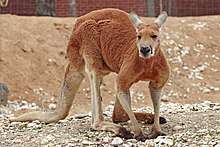
- The red kangaroo (Osphranter rufus) grows up to 1.8 m (6 ft) tall and weighs up to 85 kg (187 lb). Females grow up to 1.1 m (3 ft 7 in) tall and weigh up to 35 kg (77 lb). Tails on both males and females can be up to 1 m (3 ft 3 in) long.
- The eastern grey kangaroos (Macropus giganteus). Although a male typically weighs around 66 kg (145 lb) and stand almost 2 m (6 ft 7 in) tall, the scientific name Macropus giganteus (gigantic large-foot) is misleading, as the red kangaroo living in the semi-arid inland is larger.
- The antilopine kangaroo (Osphranter antilopinus), sometimes called the antilopine wallaroo or the antilopine wallaby, is a species of macropod found in northern Australia at Cape York Peninsula in Queensland, the Top End of the Northern Territory, and the Kimberley region of Western Australia. can weigh as much as 47 kg (104 lb) and grow over 1 m (3 ft 3 in) long.
- Common wombats (Vombatus ursinus) can reach 40 kg (88 lb). They thrive in Eastern Australia and Tasmania, preferring temperate forests and highland regions.
Birds
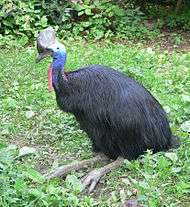
- The emu (Dromaius novaehollandiae)
- The southern cassowary (Casuarius casuarius)
Reptiles
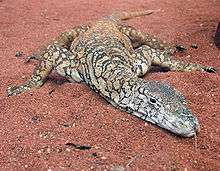
- Goannas, being predatory lizards, are often quite large or bulky, with sharp teeth and claws. The largest living goanna is the perentie (Varanus giganteus), which can grow over 2 m (6 ft 7 in) in length. Not all goannas are gargantuan though: pygmy goannas may be smaller than a man's arm.
- A healthy adult male saltwater crocodile (Crocodylus porosus) is typically 4.8–7 m (15 ft 9 in–23 ft 0 in) long and weighs around 1,000 kg (2,200 lb)), with many being much larger than this.[25] The female is much smaller, with typical body lengths of 2.5–3 m (8 ft 2 in–9 ft 10 in). An 8.5 m (28 ft) saltwater crocodile was reportedly shot on the Norman River of Queensland in 1957; a cast was made of it and is on display as a popular tourist attraction. However, due to the lack of solid evidence (other than the plaster) and the length of time since the crocodile was caught, it is not considered "official".
- The freshwater crocodile (Crocodylus johnsoni) is a relatively small crocodilian. Males can grow to 2.3–3 m (7 ft 7 in–9 ft 10 in) long, while females reach a maximum size of 2.1 m (6 ft 11 in). Males commonly weigh around 60 kg (88 lb), with large specimens up to 83 kg (120 lb) or more, against the female weight of 20 kg (44 lb). In areas such as Lake Argyle and Katherine Gorge there exist a handful of confirmed 4 m (13 ft) individuals.
Extinct Australian megafauna
The following is an incomplete list of extinct Australian megafauna (monotremes, marsupials, birds and reptiles) in the format:
- Latin name, (common name, period alive), and a brief description.
Monotremes
Monotremes are arranged by size with the largest at the top.
- Zaglossus hacketti was a sheep-sized echidna uncovered in Mammoth Cave in Western Australia, and is the largest monotreme so far uncovered.
- Obdurodon dicksoni was a platypus up to 60 cm (2 ft) in total length, fossils of which were found at Riversleigh.
- Megalibgwilia ramsayi was a large, long-beaked echidna with powerful forelimbs for digging.
Marsupials
Marsupials are arranged by size, with the largest at the top.
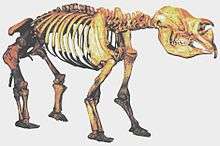
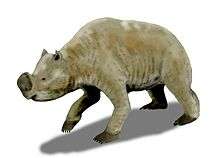
1,000–3,000 kilograms (2,200–6,610 lb)
- Diprotodon optatum is not only the largest known species of diprotodontid, but also the largest known marsupial to ever exist. Approximately 3 m (10 ft) long and 2 m (7 ft) high at the shoulder and weighing up to 2,780 kg (6,130 lb), it resembled a giant wombat. It is the only marsupial known, living or extinct, to have conducted seasonal migrations.[27]
- Zygomaturus trilobus was a smaller (bullock-sized, about 2 m (7 ft) long by 1 m (3 ft) high) diprotodontid that may have had a short trunk. It appears to have lived in wetlands, using two fork-like incisors to shovel up reeds and sedges for food.
- Palorchestes azael (the marsupial tapir) was a diprotodontoid similar in size to Zygomaturus. It had long claws and a longish trunk. It lived during the Pleistocene.[2]
- Nototherium was a diprotodontoid relative of the larger Diprotodon.
100–1,000 kilograms (220–2,200 lb)
- Euowenia grata
- Euryzygoma dunense
- Macropus pearsoni and M. ferragus
- Mukupirna nambensis, within its own family Mukupirnidae, within the Vombatiformes suborder of the large marsupial order Diprotodontia[28]
- Phascolonus gigas
- Procoptodon goliah (the giant short-faced kangaroo) is the largest-known kangaroo to have ever lived. It grew 2–3 metres (7–10 feet) tall, and weighed up to 230 kg (510 lb).
- Procoptodon rapha, P. pusio and P. texasensis
- Protemnodon, a genus of wallaby with four known giant species out of 11 known species[29]
- Palorchestes parvus
- Ramsayia magna
10–100 kilograms (22–220 lb)
- Simosthenurus pales
- Sthenurus tindalei and S. atlas
- Phascolarctos stirtoni (the giant koala) was similar in structure to the modern koala (P. cinereus), but one-third larger.
- Phascolomys medius
- Lasiorhinus angustidens
- Thylacinus cynocephalus (the thylacine, Tasmanian wolf or Tasmanian tiger)
- Congruus congruus, a wallaby from Naracoorte
- Troposodon minor
- Sthenurus oreas
- Simosthenurus occidentalis (another sthenurine) was about as tall as a modern eastern grey kangaroo, but much more robust. It is one of the nine known species of leaf-eating kangaroos identified in fossils found in Naracoorte Caves National Park.
- Simothenurus brownei
- Propleopus oscillans (the giant rat-kangaroo) was a large (about 70 kg (150 lb) rat-kangaroo with large shearing and stout grinding teeth that indicate it may have been an opportunistic omnivore able to eat invertebrates, vertebrates (possibly carrion), fruits, and soft leaves. Grew to about 1.5–3 m (5–10 ft) in height.
- Simothenurus maddocki
- Sthenurus andersoni
- Thylacoleo carnifex (the marsupial lion) is the largest known carnivorous mammal to have ever lived in prehistoric Australia, and was of comparable size to female placental mammal lions and tigers, It had a cat-like skull with large slicing pre-molars, a retractable thumb-claw and massive forelimbs. It was almost certainly carnivorous and a tree-dweller.
- Vombatus hacketti
- Macropus thor
- Macropus piltonensis
- Macropus rama
- Simothenurus gilli
- Warrendja wakefieldi, a wombat from Naracoorte
- Sarcophilus harrisii laniarius, a large subspecies of the Tasmanian devil.
- Thylacinus megiriani
Birds
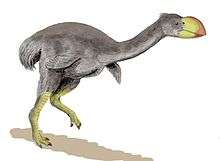
- Family Dromornithidae: this group of birds was more closely related to modern fowl than to modern ratites.
- Dromornis stirtoni, (Stirton's thunder bird or the "Demon Duck of Doom") was a flightless bird 3 m (10 ft) tall that weighed about 500 kg (1,100 lb). It is one of the largest birds so far discovered. It inhabited subtropical open woodlands and was probably carnivorous. It was heavier than the moa and taller than the elephant birds.
- Bullockornis planei was another huge member of the Dromornithidae. It was up to 2.5 m (8 ft) tall and weighed up to 250 kg (550 lb); it was probably carnivorous.
- Genyornis newtoni (the mihirung) was related to Dromornis, and was about the height of an ostrich. It was the last survivor of the Dromornithidae. It had a large lower jaw and was probably omnivorous.
- Leipoa gallinacea (formerly Progura) was a giant malleefowl.
Reptiles
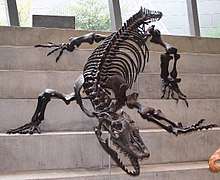
- Varanus priscus (formerly Megalania prisca) was a giant, carnivorous goanna that might have grown to as long as 7 m (23 ft), and weighed up to 1,940 kg (4,280 lb) (Molnar, 2004). Giant goannas and humans overlapped in time in Pleistocene Australia, but there is no evidence that they directly encountered each other.[30]
- Wonambi naracoortensis was a non-venomous snake of 5–6 m (16–20 ft) in length. It was an ambush predator living at waterholes located in natural sun traps and killed its prey by constriction.
- Quinkana was a terrestrial crocodile that grew from 5 m (16 ft) to possibly 7 m (23 ft) in length. It had long legs positioned underneath its body, and chased down mammals, birds and other reptiles for food. Its teeth were blade-like for cutting rather than pointed for gripping as with water dwelling crocodiles. It belonged to the mekosuchine subfamily (all now extinct). It was discovered at Bluff Downs in Queensland.
- Liasis dubudingala, lived during the Pliocene epoch, grew up to 10 m (33 ft) long, and is the largest Australian snake known. It hunted mammals, birds and reptiles in riparian woodlands. It is most similar to the extant olive python (Liasis olivacea).[31]
- Meiolania was a genus of huge terrestrial cryptodire turtle measuring 2.5 m (8 ft) in length, with a horned head and spiked tail.
Extinct megafauna contemporaneous with Aboriginal Australians
Monsters and large animals in Dreamtime stories have been associated with extinct megafauna.
The association was made at least as early as 1845, with colonists writing that Aboriginal people identified Diprotodon bones as belonging to bunyips, and Thomas Worsnop concluding that the fear of bunyip attacks at watering holes remembered a time when Diprotodon lived in marshes.[32]
In the early 1900s, John Walter Gregory outlined the Kadimakara (or Kuddimurka or Kadimerkera) story of the Diyari (similar stories being told by nearby peoples), which describes the deserts of Central Australia as having once been "fertile, well-watered plains" with giant gum trees, and almost solid cloud cover overhead. The trees created a roof of vegetation in which lived the strange monsters called Kadimakara—which sometimes came to the ground to eat. One time, the gum trees were destroyed, forcing the Kadimakara to remain on the ground, particularly Lake Eyre and Kalamurina, until they died.[33]
In times of drought and flood, the Diyari performed corroborees (including dances and blood sacrifices) at the bones of the Kadimakara to appease them and request that they intercede with the spirits of rain and clouds. Sites of Kadimakara bones identified by Aboriginal people corresponded with megafauna fossil sites, and an Aboriginal guide identified a Diprotodon jaw as belonging to the Kadimakara.[33]
Gregory speculated that the story could be a remnant from when the Diyari lived elsewhere, or when the geographical conditions of Central Australia were different. The latter possibility would indicate Aboriginal coexistence with megafauna, with Gregory saying:[33]
If, therefore, the geologist can determine whether the bones of the extinct monsters of Lake Eyre correspond to those described in the aboriginal traditions, he can throw light on several interesting problems. If the legends attribute to the extinct animals characters which they possessed, but which the natives could not have inferred from the bones, then the legends are of local origin. They would prove that man inhabited Central Australia, at the same time as the mighty diprotodon and the extinct, giant kangaroos. If, on the other hand, there is no such correspondence between the legends and the fossils, then we must regard the traditions as due to the habit of migratory peoples, of localising in new homes the incidents recorded in their folklore.
— John Walter Gregory, Dead Heart of Australia
After examining fossils, Gregory concluded that the story was a combination of the two factors, but that the environment of Lake Eyre had probably not changed much since Aboriginal habitation. He concluded that while some references to Kadimakara were probably memories of the crocodiles once found in Lake Eyre, others that describe a "big, heavy land animal, with a single horn on its forehead" were probably references to Diprotodon.[33]
Geologist Michael Welland describes from across Australia Dreamtime "tales of giant creatures that roamed the lush landscape until aridity came and they finally perished in the desiccated marshes of Kati Thanda–Lake Eyre", giving as examples the Kadimakara of Lake Eye, as well as continent-wide stories of the Rainbow Serpent, which he says corresponds with Wonambi naracoortensis.[34]
Journalist Peter Hancock speculates in The Crococile That Wasn't that a Dreamtime story from the Perth area could be a memory of Varanus priscus.[35]
Rock art in the Kimberley region appears to depict a marsupial lion[36] and a marsupial tapir,[37] as does Arnhem land art.[38] Arnhem art also appears to depict Genyornis, a bird that is believed to have gone extinct 40,000 years ago.[39]
An Early Triassic archosauromorph found in Queensland, Kadimakara australiensis, is named after the Kadimakara.[40]
See also
- Cuddie Springs – Archaeological site in Australia
- Quaternary extinction event – Mass extinction event, around 10000 BCE, marking the end of the Pleistocene and the beginning of the Holocene
References
- Roberts, R. G.; Flannery, T. F.; Ayliffe, L. K.; Yoshida, H.; Olley, J. M.; Prideaux, G. J.; Laslett, G. M.; Baynes, A.; Smith, M. A.; Jones, R.; Smith, B. L. (2001-06-08). "New Ages for the Last Australian Megafauna: Continent-Wide Extinction About 46,000 Years Ago" (PDF). Science. 292 (5523): 1888–1892. Bibcode:2001Sci...292.1888R. doi:10.1126/science.1060264. PMID 11397939. Retrieved 2011-08-26.
- Mackness, B.S. (2009). "Reconstructing Palorchestes (Marsupialia: Palorchestidae) – from Giant Kangaroo to Marsupial 'Tapir'". Proceedings of the Linnean Society of New South Wales. 130: 21–36.
- Miller, G. H. (2005). "Ecosystem Collapse in Pleistocene Australia and a Human Role in Megafaunal Extinction". Science. 309 (5732): 287–290. Bibcode:2005Sci...309..287M. doi:10.1126/science.1111288. PMID 16002615.
- Wroe, S.; Field, J. H.; Archer, M.; Grayson, D. K.; Price, G. J.; Louys, J.; Faith, J. T.; Webb, G. E.; Davidson, I.; Mooney, S. D. (2013-05-28). "Climate change frames debate over the extinction of megafauna in Sahul (Pleistocene Australia-New Guinea)". Proceedings of the National Academy of Sciences. 110 (22): 8777–8781. doi:10.1073/pnas.1302698110. ISSN 0027-8424. PMC 3670326. PMID 23650401.
- Prideaux, G. J.; Long, J. A.; Ayliffe, L. K.; Hellstrom, J. C.; Pillans, B.; Boles, W. E.; Hutchinson, M. N.; Roberts, R. G.; Cupper, M. L.; Arnold, L. J.; Devine, P. D.; Warburton, N. M. (2007-01-25). "An arid-adapted middle Pleistocene vertebrate fauna from south-central Australia". Nature. 445 (7126): 422–425. Bibcode:2007Natur.445..422P. doi:10.1038/nature05471. PMID 17251978.
- Saltré, Frédérik; Rodríguez-Rey, Marta; Brook, Barry W.; Johnson, Christopher N; Turney, Chris S. M.; Alroy, John; Cooper, Alan; Beeton, Nicholas; Bird, Michael I.; Fordham, Damien A.; Gillespie, Richard; Herrando-Pérez, Salvador; Jacobs, Zenobia; Miller, Gifford H.; Nogués-Bravo, David; Prideaux, Gavin J.; Roberts, Richard G.; Bradshaw, Corey J. A. (2016). "Climate change not to blame for late Quaternary megafauna extinctions in Australia". Nature Communications. 7: 10511. Bibcode:2016NatCo...710511S. doi:10.1038/ncomms10511. ISSN 2041-1723. PMC 4740174. PMID 26821754.
- Diamond, Jared (2008-08-13). "Palaeontology: The last giant kangaroo". Nature. 454 (7206): 835–836. Bibcode:2008Natur.454..835D. doi:10.1038/454835a. PMID 18704074.
- Turney, C. S. M.; Flannery, T. F.; Roberts, R. G.; et al. (2008-08-21). "Late-surviving megafauna in Tasmania, Australia, implicate human involvement in their extinction". Proceedings of the National Academy of Sciences of the United States of America. 105 (34): 12150–12153. Bibcode:2008PNAS..10512150T. doi:10.1073/pnas.0801360105. PMC 2527880. PMID 18719103. Retrieved 2011-05-08.
- Roberts, R.; Jacobs, Z. (October 2008). "The Lost Giants of Tasmania" (PDF). Australasian Science. 29 (9): 14–17. Archived from the original (PDF) on 2011-09-27. Retrieved 2011-08-26.
- Biello, D. (2012-03-22). "Big Kill, Not Big Chill, Finished Off Giant Kangaroos". Scientific American. Retrieved 2012-03-25.
- McGlone, M. (2012-03-23). "The Hunters Did It". Science. 335 (6075): 1452–1453. Bibcode:2012Sci...335.1452M. doi:10.1126/science.1220176. PMID 22442471.
- Rule, S.; Brook, B. W.; Haberle, S. G.; Turney, C. S. M.; Kershaw, A. P. (2012-03-23). "The Aftermath of Megafaunal Extinction: Ecosystem Transformation in Pleistocene Australia". Science. 335 (6075): 1483–1486. Bibcode:2012Sci...335.1483R. doi:10.1126/science.1214261. PMID 22442481.
- Dodson, J.; Field, J.H. (May 2018). "What does the occurrence of Sporormiella (Preussia) spores mean in Australian fossil sequences?". Journal of Quaternary Science. 33 (4): 380–392. doi:10.1002/jqs.3020.
- Hocknull, Scott A.; Lewis, Richard; Arnold, Lee J.; Pietsch, Tim; Joannes-Boyau, Renaud; Price, Gilbert J.; Moss, Patrick; Wood, Rachel; Dosseto, Anthony; Louys, Julien; Olley, Jon (2020-05-18). "Extinction of eastern Sahul megafauna coincides with sustained environmental deterioration". Nature Communications. 11 (1): 1–14. doi:10.1038/s41467-020-15785-w. ISSN 2041-1723.
- Miller, Gifford; Magee, John; Smith, Mike; Spooner, Nigel; Baynes, Alexander; Lehman, Scott; Fogel, Marilyn; Johnston, Harvey; Williams, Doug; Clark, Peter; Florian, Christopher; Holst, Richard & DeVogel, Stephen (29 January 2016). "Human predation contributed to the extinction of the Australian megafaunal bird Genyornis newtoni ~ 47 ka". Nature Communications. 7 (10496): 10496. Bibcode:2016NatCo...710496M. doi:10.1038/ncomms10496. PMC 4740177. PMID 26823193.CS1 maint: uses authors parameter (link)
- Grellet-Tinner, Gerald; Spooner, Nigel A.; Worthy, Trevor H. (February 2016). "Is the "Genyornis" egg of a mihirung or another extinct bird from the Australian dreamtime?". Quaternary Science Reviews. 133: 147–164. doi:10.1016/j.quascirev.2015.12.011. hdl:2328/35952.
- "Humans, not climate change, wiped out Australian megafauna". phys.org. Retrieved 30 May 2017.
- "Aboriginal archaeological discovery in Kakadu rewrites the history of Australia". Smh.com.au. 2017-07-20. Retrieved 2018-06-05.
- Olley, Jon. "Aboriginal Australians co-existed with the megafauna for at least 17,000 years". theconversation.com. Retrieved 30 May 2017.
- Wroe, Stephen; Field, Judith H.; Archer, Michael; Grayson, Donald K.; Price, Gilbert J.; Louys, Julien; Faith, J. Tyler; Webb, Gregory E.; Davidson, Iain; Mooney, Scott D. (28 May 2013). "Climate change frames debate over the extinction of megafauna in Sahul (Pleistocene Australia-New Guinea)". Proceedings of the National Academy of Sciences. 110 (22): 8777–8781. Bibcode:2013PNAS..110.8777W. doi:10.1073/pnas.1302698110. PMC 3670326. PMID 23650401.
- "The Future Eaters – It's critics". www.abc.net.au. Retrieved 30 May 2017.
- "The Flannery eaters". www.smh.com.au. Retrieved 30 May 2017.
- Westaway, Michael C.; Olley, Jon; Grün, Rainer (February 2017). "At least 17,000 years of coexistence: Modern humans and megafauna at the Willandra Lakes, South-Eastern Australia". Quaternary Science Reviews. 157: 206–211. doi:10.1016/j.quascirev.2016.11.031.
- Danielle Clode (2009) Prehistoric giants: the megafauna of Australia, Museum Victoria ISBN 978-0-9803813-2-0
- Vanderwal and Fullager 1989 as cited in Josephine Flood (2004) Archaeology of the Dreamtime, J.B Publishing, Marleston p, 182 ISBN 1-876622-50-4
- Flannery. The Pleistocene extinctions as cited in Josephine Flood (2004) Archaeology of the Dreamtime, J.B. Publishing, Marleston p. 178 ISBN 1-876622-50-4
- Price, Gilbert J.; Ferguson, Kyle J.; Webb, Gregory E.; Feng, Yue-xing; Higgins, Pennilyn; Nguyen, Ai Duc; Zhao, Jian-xin; Joannes-Boyau, Renaud; Louys, Julien (2017-09-27). "Seasonal migration of marsupial megafauna in Pleistocene Sahul (Australia–New Guinea)". Proc. R. Soc. B. 284 (1863): 20170785. doi:10.1098/rspb.2017.0785. ISSN 0962-8452. PMC 5627191. PMID 28954903.
- Salleh, Anna (25 June 2020). "Fossil of modern wombats' giant extinct cousin found in US museum, 50 years after initial discovery". ABC News (ABC Science). Australian Broadcasting Corporation. Retrieved 30 June 2020.
- Helgen, K.M.; Wells, R.T.; Kear, B.P.; Gerdtz, W.R.; Flannery, T.F. (2006). "Ecological and evolutionary significance of sizes of giant extinct kangaroos". Australian Journal of Zoology. 54 (4): 293–303. doi:10.1071/ZO05077.
- Price, Gilbert J.; Louys, Julien; Cramb, Jonathan; Feng Yue-xing; Zhao Jian-xin; Hocknull, Scott A.; Webb, Gregory E.; Nguyen Ai Duc; Joannes-Boyau, Renaud (2015-10-01). "Temporal overlap of humans and giant lizards (Varanidae; Squamata) in Pleistocene Australia". Quaternary Science Reviews. 125: 98–105. Bibcode:2015QSRv..125...98P. doi:10.1016/j.quascirev.2015.08.013.
- Scanlon, JD; Mackness, BS. (2001). "A new giant python from the Pliocene Bluff Downs Local Fauna of northeastern Queensland". Alcheringa. 25 (4): 425–437. doi:10.1080/03115510108619232.
- Holden, Robert; Holden, Nicholas (2001). Bunyips: Australia's Folklore of Fear. National Library Australia. pp. 87–91. ISBN 978-0642107329.
- Gregory, J. W. (John Walter) (1906). The dead heart of Australia. University of California Libraries. London : J. Murray. pp. 3–7, 74, 224, 230–235.
- Welland, Michael (September 2017). "So the land is actually like a big book, you know?" (PDF). Global Land Outlook: 9–10.
- "WA history author goes digital". PerthNow. 2012-09-11. Retrieved 2018-05-12.
- Akerman, Kim. "An ancient rock painting of a marsupial lion, Thylacoleo carnifex, from the Kimberley, Western Australia".
- "More Megafaunal Depictions in Bradshaw Rock Art" (PDF).
- Murray, Peter; Chaloupka, George (October 1984). "The Dreamtime animals: extinct megafauna in Arnhem Land rock art". Archaeology in Oceania. 19 (3): 105–116. doi:10.1002/j.1834-4453.1984.tb00089.x. ISSN 0728-4896.
- "Megafauna cave painting could be 40,000 years old". ABC News. 2010-05-31. Retrieved 2018-05-12.
- Ezcurra, Martín D. (2016-04-28). "The phylogenetic relationships of basal archosauromorphs, with an emphasis on the systematics of proterosuchian archosauriforms". PeerJ. 4: e1778. doi:10.7717/peerj.1778. ISSN 2167-8359. PMC 4860341. PMID 27162705.
- Field, J. H.; Dodson, J. (1999). "Late Pleistocene megafauna and archaeology from Cuddie Springs, south-eastern Australia". Proceedings of the Prehistoric Society. 65: 1–27. doi:10.1017/S0079497X00002024.
- Field, J. H.; Boles, W. E. (1998). "Genyornis newtoni and Dromaius novaehollandiae at 30,000 b.p. in central northern New South Wales". Alcheringa. 22 (2): 177–188. doi:10.1080/03115519808619199.
- Long, J.A., Archer, M. Flannery, T.F. & Hand, S. (2003). Prehistoric Mammals of Australia and New Guinea −100 Million Years of Evolution. Johns Hopkins University Press, Baltimore. 242 pp.
- Molnar, R. (2004). Dragons in the Dust: The Paleobiology of the Giant Lizard Megalania. Indiana University Press. p. 127.
- Murray, P. F.; Megirian, D. (1998). "The skull of dromornithid birds: anatomical evidence for their relationship to Anseriformes (Dromornithidae, Anseriformes)". Records of the South Australian Museum. 31: 51–97.
- Wroe, S.; Field, J.; Fullagar, R. (2002). "Lost giants". Nature Australia. 27 (5): 54–61.
- Prideaux, Gavin J; Roberts, Richard G.; Megirian, Dirk; Westaway, Kira E.; Hellstrom, John C.; Olley, John M. (2007). "Mammalian responses to Pleistocene climate change in southeastern Australia" (PDF). Geology. 35 (1): 33–36. Bibcode:2007Geo....35...33P. doi:10.1130/G23070A.1.